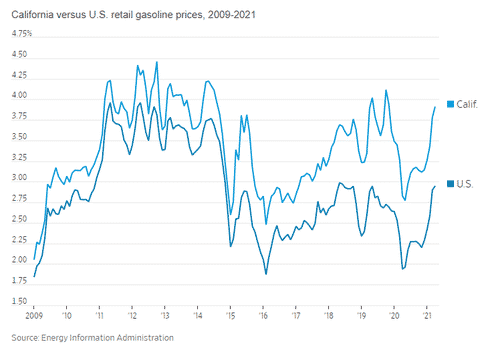Get ready for $5 per gallon gasoline – especially if you live in California.
At least, that was the contention of a new WSJ op-ed that claims higher taxes and environmental regulations are both driving up the price of gas.
Author Allysia Finley notes that the average cost at the pump in California is now $4.18 a gallon, pointing out that in 2017, Democrats in the state’s legislature raised a tax on each gallon by 20.8 cents over three years.
California drivers are now paying an astonishing average of 63 cents a gallon in state and local taxes, compared an average of 36.8 cents elsewhere in the country.
The reasoning for the price hike was to repair the state’s infrastructure, but instead the proceeds have been “directed toward projects aimed at reducing greenhouse gas emissions, such as bike lanes and mass transit,” the op-ed notes.
The California Air Resources Board is also responsible for imposing a tax through its cap and trade program, which has added about 14 cents per gallon to the state’s average gas price.
CARB requires that retailers sell “a special extra-clean-burning gasoline blend” which raises the price about another 10 cents per gallon. The Board “assigns carbon-intensity scores to hundreds of fuels” and requires refiners to meet a low score to blend lower-carbon fuels. If they can’t meet the threshold, they are forced to buy carbon credits, which also drives up the price of fuel.
The board awards these credits to utilities when their customers charge EVs at home. Utilities then turn around and sell the credits to refiners. Gas powered vehicle drivers are subsidizing thousands in incentives to EV buyers, the op-ed notes:
So Californians can get a $1,500 rebate from their local utility on top of $2,000 from the state and $7,500 from the feds for buying an electric vehicle. Sweet.
Yet drivers of gasoline-powered cars are subsidizing the utility rebates through higher fuel prices. As the state’s carbon-intensity benchmark has fallen, prices for regulatory credit prices have soared—from $17 on average in 2012 to $198 in the first quarter of this year. An analysis last fall by Stillwater Associates estimated that the program would add 24 cents a gallon to the price of gasoline this year and 63 cents by 2030.
Refiners, as a result of the rules in the state, are switching to producing renewable fuels, which are now “much more profitable” due to regulatory and tax credits. But the infrastructure conversion that refineries will have to undertake to produce this fuel – such as Marathon Petroleum recent planning to convert a refinery in California – will once again wind up in rising prices for California drivers.
In fact, many refineries have simply closed due to the burdensome regulations. This means that when the remaining refineries experience outages, price spikes are more severe.
“Californian drivers can soon look forward to paying more than $5 a gallon at the pump as the state’s green mandates ratchet up and gasoline refineries shut down or convert to renewable fuels,” the op-ed concludes.






